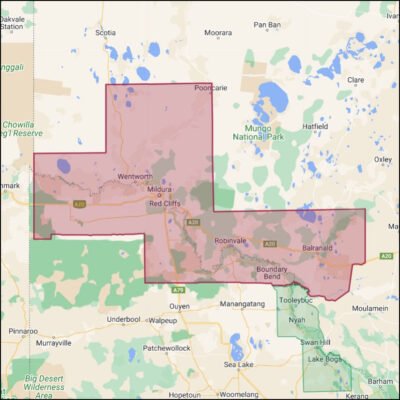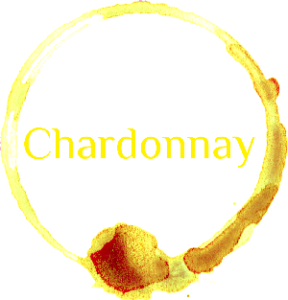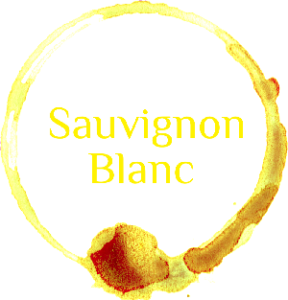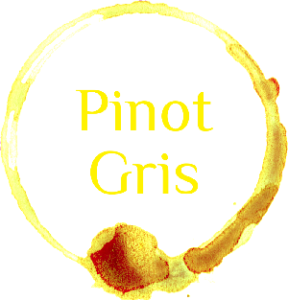The Murray Darling region is located in the northwest corner of Victoria, extending into New South Wales, near the Murray and Darling Rivers junction. These are Australia’s longest and third-longest rivers, respectively. This is one of Australia’s largest and most productive wine regions. Known for its warm, sunny climate and vast, irrigated vineyards, Murray Darling produces a significant portion of the country’s bulk wine.
Combined with Swan Hill immediately to the southeast, this is the third-largest winegrowing region in Australia after the Riverland (South Australia) and Riverina (New South Wales). Although the distance from east to west of the region is more than 350 kilometres, the climate throughout is virtually identical.
This area is largely flat, with a warm, semi-arid climate, making it ideal for large-scale viticulture. The Murray and Darling Rivers provide vital water resources for the region, enabling extensive irrigation. Without these rivers, viticulture in this area would be almost impossible due to the dry climate. The soils here are mostly alluvial, with sand, clay, and loam, which are well-suited for growing a wide range of grape varieties. These soils are fertile and, with irrigation, can support high-yielding vineyards. The climate is warm and dry, with long, hot summers and very low rainfall. This warm climate is ideal for producing ripe, fruit-forward wines. The region receives plentiful sunshine, ensuring consistent grape ripening year after year.
The region was the brainchild of Australian Politician and later Prime Minister Alfred Deakin. He was inspired after a visit to California in the 1880’s, when he saw the power that could be unleashed through irrigation. He managed to lure two irrigation engineers (George and Wiliam Chaffey) back to Australia to expose the potential of the Murray River to the endless land surrounding it. Bureaucratic delays in obtaining rights to the water saw the project stall, and the Chaffey brothers moved to South Australia in 1887 for a project that had government support. After their success in SA, the government agreed to terms, and they moved back to Victoria to begin the project. It saw Mildura grow from a handful of locals to a population of 3,000 by 1890, many making homes on the 4-hectare lots now supplied with water.
There were many stop-starts, but consistent winemaking was born in the late 1930s with the arrival of the Mildara Wine Company, which traded until 2004. Other large producers made the region home. McWilliams opened their Robinvale Winery in 1952 and Lindemans Karadoc in 1974. Stanley Buronga was acquired in 1984 (now part of Accolade Wines), the same year as Buronga Hill Winery (now owned by Australian Vintage)
Throughout the mid-20th century, Murray Darling became one of Australia’s most productive wine regions, focusing on high-volume production for domestic and export markets. The region produces a wide range of fruit-forward, approachable wines. The warm climate allows for producing ripe, full-bodied reds and aromatic whites, making it a diverse region for various grape varieties.
Top Stats
Harvest
Early Feb to mid Mar
Mean Jan temperature
23.7°C
Area of Vine
16,068 hectares
Altitude
19 – 134m
Growing season rainfall
162mm
Principal Varietals
A touch over one-quarter of the vast volume of wine that leaves the Murray Darling wine region is Chardonnay. It is one of the region’s most widely planted varieties, and the finished product ranges from fresh and fruit-driven to richer, oaked styles. Common flavours include peach, melon, and tropical fruits, often with a creamy texture if oak is used in the winemaking process.
The warm climate of this region is ideal for growing Shiraz, which accounted for 18% of the crush in 2023. This varietal ripens well and produces wines with ripe berry flavours, spice, and soft tannins. Shiraz from the region tends to be plush, fruit-driven, and approachable, making it popular for entry-level and mid-tier wines.
Despite Sauvignon Blanc being more commonly associated with cooler climates, the grape still performs well here, producing wines with tropical fruit, melon, and citrus notes, with less herbaceousness than found in cooler regions. This grape made up 12% of the crush in 2023
Known for its dark fruit flavours, blackcurrant, and herbal notes, Cabernet Sauvignon (9% of crush) thrives in this region. The warm conditions result in ripe, bold wines that are often smooth and easy to drink, with lower tannin structures compared to cooler-climate examples.
Pinot Gris is gaining popularity in this warm-climate region. While this grape is traditionally associated with cooler climates like Alsace and Northern Italy, Murray Darling offers a unique interpretation of the varietal, producing fruit-forward, approachable wines with ripe flavours and a softer acidity than cooler regions. It comes in fifth with 7% of the 2023 crush.
Noteable Varietals
Known for its soft tannins and plum and berry flavours, Merlot from Murray Darling is typically smooth and easy-drinking. It is a popular choice for red wine lovers seeking something approachable.
Murray Darling also grows a wide variety of other grapes, including Semillon, Colombard, Prosecco and Malbec all contributing to the region’s diversity.
Source: www.wineaustralia.com,









